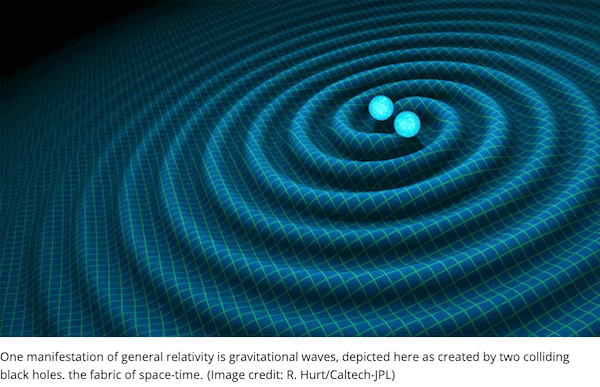What is time?
the measured or measurable period during which an action, process, or condition exists or continues : duration. b : a nonspatial continuum that is measured in terms of events which succeed one another from past through present to future.
But we don’t really understand it, we just know how to measure it.
Our concepts of Past, Present and Future are just our constructs. There isn’t really any present, it is just an illusion.
Einstein says that time is the fourth dimension related to space-time. Some more info here.
Einstein showed us that time is just a fourth dimension and that there is nothing special about ‘now’; even ‘past’ and ‘future’ are not always well defined. The malleability of space and time mean that two events occurring far apart might even happen in one order when viewed by one observer, and in the opposite order when viewed by another.

What is the theory of general relativity?

The essence of relativity is that there is no absolute time, no absolute space. Everything is relative. When you try to discuss time in the context of the universe, you need the simple idea that you isolate part of the universe and call it your clock, and time evolution is only about the relationship between some parts of the universe and that thing you called your clock.
According to Einstein’s own theories, time moves differently for someone below sea level than for someone situated on the highest peaks on the planet (according to some studies, “at sea level you age one-billionth of a second less every year than you would if you lived on top of Mt. Everest.”). This is due to a phenomenon posited by general relativity called gravitational time dilation.
The logic behind gravitational time dilation is fairly simple: Objects with a lot of mass create a strong gravitational field. This gravitational field noticeably warps the fabric of spacetime around these objects, producing what we know as gravity. When a stream of light particles passes by an object with sufficient gravity, the stream of photons traveling at the speed of light would appear to bend.
Time Dilation
Perhaps the strangest example of time dilation can be seen in and around black holes. Time ticks much differently the closer you get to the event horizon of a black hole. Imagine that you had two clocks — one held by an observer beyond the immensely strong gravity of the object, and another held by an observer passing near the event horizon — the clock farther away would tick faster than the one close to the event horizon.
From the point of view of the observer near the event horizon, one day may have passed, while the person observing from the outside may have experienced a decade of time. Eventually, time may appear to stop altogether for the observer near the event horizon.
Researchers have actually observed this effect, which is only detectable at high speeds. Scientists synchronized two highly accurate atomic clocks and then flew one around the Earth aboard an airplane. When the airborne clock returned to Earth, it was a tiny fraction of a second behind the one that remained on the ground. A thought experiment using a light clock reveals why this is so.
What is quantum mechanics?
Quantum mechanics is the branch of physics relating to the very small – the scale of atoms and electrons. many of the equations of classical mechanics, which describe how things move at everyday sizes and speeds, cease to be useful. In classical mechanics, objects exist in a specific place at a specific time. However, in quantum mechanics, objects instead exist in a haze of probability; they have a certain chance of being at point A, another chance of being at point B and so on.
Quantized properties: Certain properties, such as position, speed and color, can sometimes only occur in specific, set amounts, much like a dial that “clicks” from number to number. This challenged a fundamental assumption of classical mechanics, which said that such properties should exist on a smooth, continuous spectrum. To describe the idea that some properties “clicked” like a dial with specific settings, scientists coined the word “quantized.”
Particles of light: Light can sometimes behave as a particle. This was initially met with harsh criticism, as it ran contrary to 200 years of experiments showing that light behaved as a wave; much like ripples on the surface of a calm lake. Light behaves similarly in that it bounces off walls and bends around corners, and that the crests and troughs of the wave can add up or cancel out. Added wave crests result in brighter light, while waves that cancel out produce darkness. A light source can be thought of as a ball on a stick being rhythmically dipped in the center of a lake. The color emitted corresponds to the distance between the crests, which is determined by the speed of the ball’s rhythm.
Waves of matter: Matter can also behave as a wave. This ran counter to the roughly 30 years of experiments showing that matter (such as electrons) exists as particles.
What is thermodynamics?
-
The zeroth law of thermodynamics. When two systems are each in thermal equilibrium with a third system, the first two systems are in thermal equilibrium with each other. This property makes it meaningful to use thermometers as the “third system” and to define a temperature scale.
-
The first law of thermodynamics, or the law of conservation of energy. The change in a system’s internal energy is equal to the difference between heat added to the system from its surroundings and work done by the system on its surroundings.
-
The second law of thermodynamics. Heat does not flow spontaneously from a colder region to a hotter region, or, equivalently, heat at a given temperature cannot be converted entirely into work. Consequently, the entropy of a closed system, or heat energy per unit temperature, increases over time toward some maximum value. Thus, all closed systems tend toward an equilibrium state in which entropy is at a maximum and no energy is available to do useful work.
-
The third law of thermodynamics. The entropy of a perfect crystal of an element in its most stable form tends to zero as the temperature approaches absolute zero. This allows an absolute scale for entropy to be established that, from a statistical point of view, determines the degree of randomness or disorder in a system.
Although thermodynamics developed rapidly during the 19th century in response to the need to optimize the performance of steam engines, the sweeping generality of the laws of thermodynamics makes them applicable to all physical and biological systems.
This article covers classical thermodynamics, which does not involve the consideration of individual atoms or molecules. Such concerns are the focus of the branch of thermodynamics known as statistical thermodynamics, or statistical mechanics, which expresses macroscopic thermodynamic properties in terms of the behaviour of individual particles and their interactions. It has its roots in the latter part of the 19th century, when atomic and molecular theories of matter began to be generally accepted.
You can read more on Brittanica here.
What is entropy?
the second law of thermodynamics: Entropy goes up with time, things become more disorderly. So, if you neatly stack papers on your desk, and you walk away, you’re not surprised they turn into a mess.
The idea of time being frozen, dynamic motion in time and illusion to us embedded in the space, is not really modern, it’s as ancient as any records and the ancient Greeks, were very elaborate on the idea we cannot escape our fate, our death can be seen in the Oracle like something already there.
There are lots more interesting questions to ask:
What is temperature?
What is consciousness?
What is the block universe theory?
Do we have free will? or is it an illusion?

